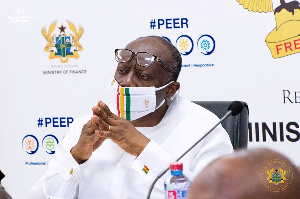 Finance Minister, Ken Ofori-Atta
Finance Minister, Ken Ofori-Atta
The International Monetary Fund (IMF) has projected the country’s public debt to hit 83.5 percent of Gross Domestic Product (GDP) by end of the year, thereby throwing the economy into the dreaded list of debt-distressed countries.
Already, the country is in the basket of economies at high risk of debt-distress – as the IMF data published after its directors concluded the Article IV Consultation with government show the country’s gross public debt hit 78.9 percent of GDP in 2020, contrary to 76.1 percent reported by the Summary of Economic and Financial data. This technically means that for every GH¢1 worth of economic activity produced in the country in 2020, 78.9 pesewas was classified as debt.
So, for the economy to plunge into the list of debt-distressed countries, should the IMF forecast come true, means the difficulty currently facing government as it tries to revive and recover various pandemic-hit sectors will be further compounded. The IMF is therefore urging government to put in place robust macroeconomic structures which will ensure fiscal consolidation in order to avert that fate.
“Fiscal consolidation is needed to address debt sustainability and rollover risks, as Ghana continues to be classified as at high risk of debt-distress. To protect the most vulnerable, consideration could be given to more progressive revenue measures and a faster return to the pre-pandemic level of spending, with a shift toward social, health and development spending. Directors also encouraged a timely completion of the planned audit of COVID‑19 emergency spending and new expenditure arrears.
“While there are encouraging signs of an economic recovery, they noted that it remains uneven across sectors. In this context, directors stressed the importance of entrenching prudent macroeconomic policies, ensuring debt sustainability, and pressing ahead with structural reforms to deliver a sustainable, inclusive, and green economic recovery,” the statement said.
Besides the high public debt, the fiscal deficit including energy and financial sector costs worsened to 15.2 percent of GDP, with a further 2.1 percent of GDP in additional spending financed through the accumulation of domestic arrears, the report stated.
Growth
The IMF however projects the economy to rebound strongly to 4.7 percent in 2021, compared to the 0.4 percent recorded in the first year of the pandemic (2020). This growth, the Fund says, is supported by a strong cocoa season, mining and services activity.
Also, the current account deficit is projected to improve to 2.2 percent of GDP from the 3.1 percent recorded in 2020, supported by a pickup in oil prices, and gross international reserves are expected to remain stable. However, the IMF cautioned that this and other projections in the budget – such as the fiscal deficit of 13.9 percent of GDP – are uncertain, given new waves of the pandemic.
The IMF further emphasised that government’s digitisation drive and structural transformation are key to recovering the economy.
“Structural transformation and digitalisation agenda are critical to support the recovery. The structural transformation can be complemented by the ongoing energy sector review, diversification in tourism, and the digital transition which has the potential to reduce corruption, boost tax revenues, and improve service delivery,” the statement said.